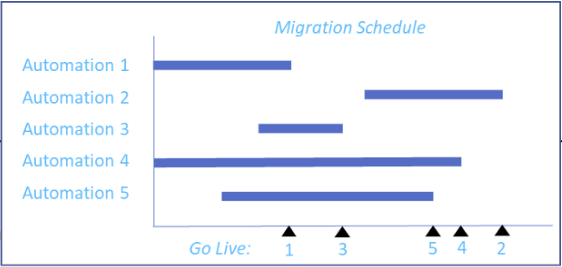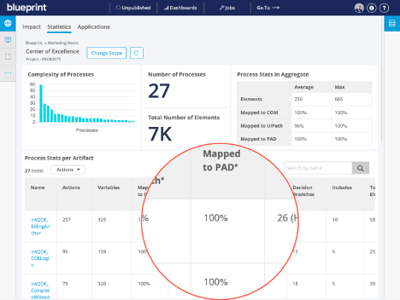How to Prioritize Automated Processes for RPA Migration
So you’ve decided to migrate your RPA estate onto a new, more cost-efficient and powerful intelligent automation platform like Microsoft Power Automate. You’ve done all your due diligence, created a solid business case for RPA migration, and performed your feasibility assessments.
Now it’s time to strategically and efficiently plan your RPA migration. Strategic planning can limit the amount of time you’ll have to pay for two RPA platforms executing parallel runs as you migrate. It also gives you the opportunity to assess your RPA estate and determine which processes are worth migrating and which are better retiring because they’re redundant or are delivering insufficient returns.
After you’ve assessed your automation estate, you’ll want to define the scope for the automated processes you want to migrate and determine the waves or sprints of the actual migration.
One element of RPA migrations that organizations have a difficult time grasping is prioritizing automated processes they want to move over to their new intelligent automation platform. Are you going to tackle the most complex automated processes and work your way down to the low-hanging fruit? Or start with the simple automations so you can learn on the fly to make the migration of the more complex automated processes quicker and easier?
In this article, we explain how to determine if an automated process should be migrated to your new RPA platform in the first place, and what criteria to consider when defining your waves and sprints for RPA migration.
Prioritizing Automations for Migration
When planning and mapping out your RPA migration, the first thing to consider is whether an automated processes should indeed be migrated or not.
Each and every automation should be assessed to determine whether it delivers sufficient business value and warrants being ported over to your new RPA platform. For example, in an RPA migration Blueprint completed with a major North American telecom provider, roughly 600 automations were identified that were high-cost, redundant, or just of poor quality. It was decided that those automations should be retired, saving that client $5 million dollars in licensing fees, migration costs, and future maintenance headaches down the road.
Learn More: Read the full case study here
Once you’ve defined the automations that are of high-quality and deliver sufficient business value, you should then prioritize which wave or sprint each automation will be migrated in. To do that, you can follow simple considerations to determine how to prioritize your automated processes for migration according to a cadence of migration sprints or waves.

Prioritization Criteria to Follow for Automated Processes in RPA Migrations
The following are the typical considerations you should use when prioritizing automated processes for migration into your new, destination RPA platform:
Business Criticality
Business critical automations are normally the first processes identified for early migration, however, it’s a good practice to migrate those automations during the last phases of the project.
Migrating less business-critical processes early in your RPA migration project enables you to stabilize the destination environment and operations without running into any show-stoppers. If a business-critical automation is running well without any issues in the legacy, origin RPA environment without any time-sensitive dependencies like license expiries, then waiting until the latter stages to move it over is a sound decision.
Size and Complexity
Large, complex automations are often prioritized to be migrated earlier in RPA migration projects because they’re more challenging to migrate and less predictable.
Migrating these automations earlier reduces the risk of migration projects experiencing delays and helps them stay on schedule by tackling complexity early and ramping up later on with simpler automated processes.
Number and Nature of Applications
If the automated process interacts with numerous applications and/or those applications are complex or novel, this can introduce complexity into the migration and make it less predictable. Migrating these kinds of processes earlier in the migration tends to reduce risk and keep the entire project on track and on time.
Degree of Automatic Migration
The degree to which an automation can be migrated automatically with Blueprint’s RPA Migration solution determines how much manual coding work and effort is required.
Automated processes with a low degree of automatic migration can be more challenging to migrate to your destination RPA platform, so these should be prioritized to be completed earlier in the project. Blueprint’s RPA Analytics and Dashboards and the reports produced therein are used to determine the degree of automatic migration and therefore offer invaluable guidance into prioritizing your automation estate for migration.

When planning out your RPA migration project, there is a lot to consider. Most importantly, the first crucial step is to perform an automation assessment and determine which automated processes are delivering sufficient business value and should be migrated over to your destination RPA platform instead of retiring them to cut costs and unwanted future issues.
The second step is prioritizing when each automation will be migrated according to the following prioritization criteria:
- Business criticality
- Size and complexity
- Number and nature of applications
- Degree of automatic migration.
Share this
Recent Stories

The Difference Between Migrating and Re-platforming Your Automation Estate

What is Blueprint’s Certified Partner Program? Everything You Need to Know



